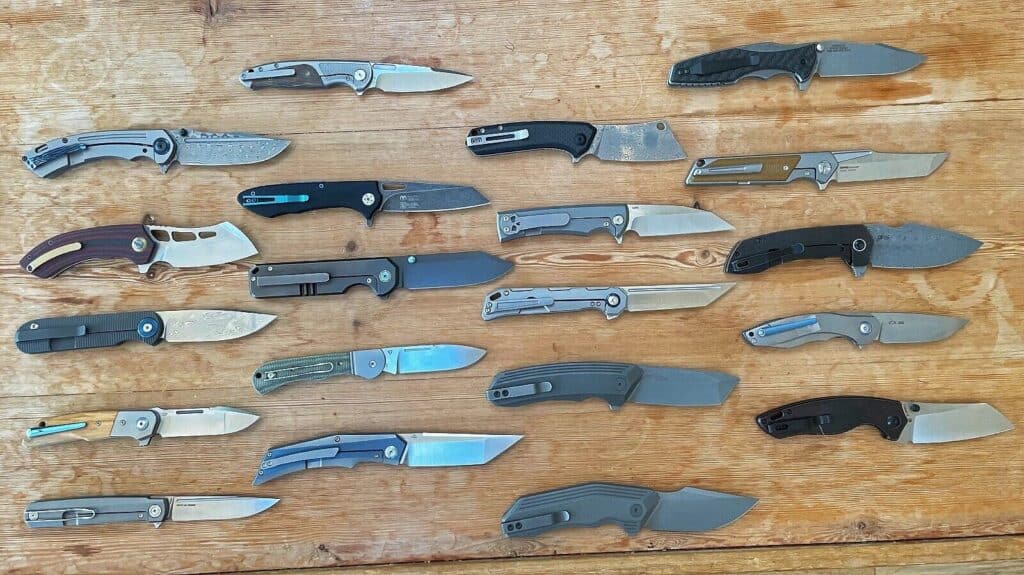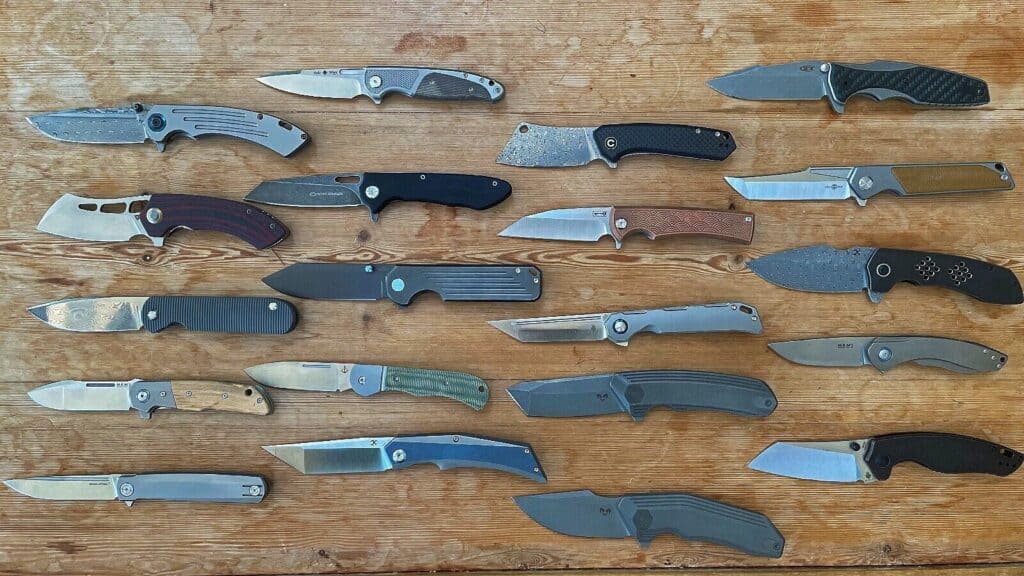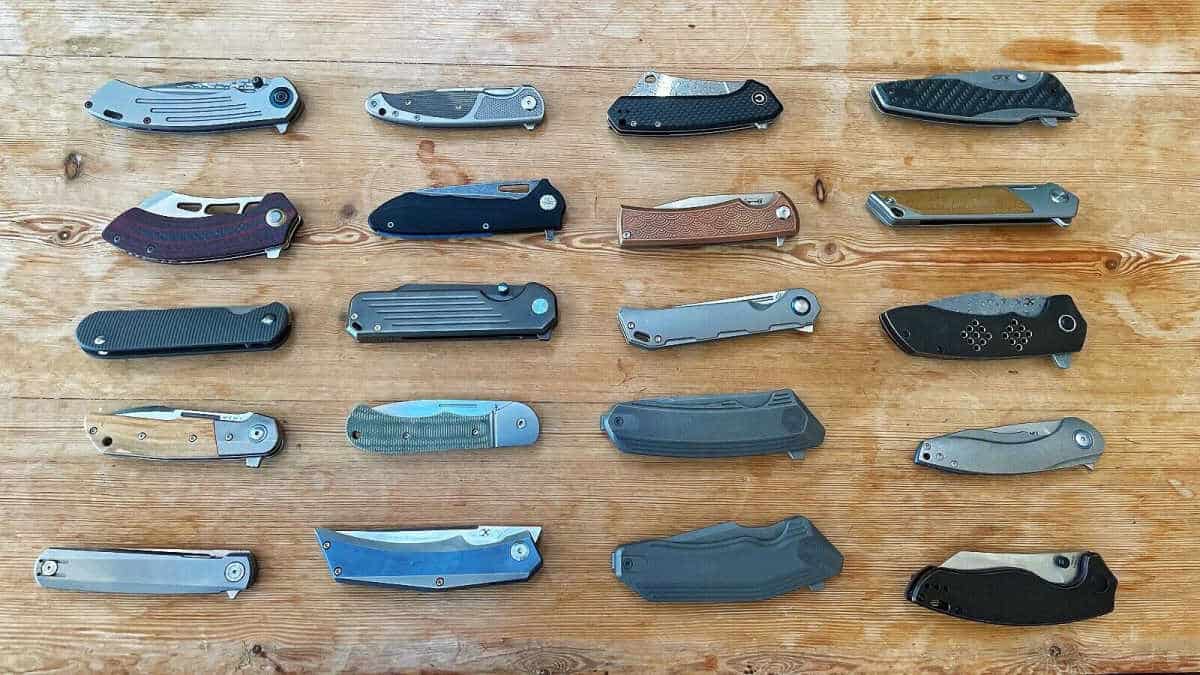As an Amazon Associate I earn from qualifying purchases.
Collecting knives can be a rewarding hobby, but there may come a time when you wish to sell your knife collection. Whether you’re downsizing your collection, looking for a fresh start, or seeking some extra cash, finding the right place to sell your knives is important.
There are several avenues to explore when selling a knife collection, from online platforms to specialist dealers. Each option has its own perks and drawbacks, so it’s crucial to assess which method best suits your needs. In this article, we’ll discuss various options for selling your knives and provide insight into the factors to consider when choosing where to sell your collection.
When selling your knife collection, it’s essential to know the approximate value and condition of your knives to ensure a fair sale price. Do your research and familiarize yourself with the market, including demand for specific brands and models. Armed with this knowledge, you’ll be better prepared to sell your collection at the right price and location.
Where to Sell Your Knife Collection – 5 Options
Selling your knife collection can feel like a daunting task, especially if you’re not sure where to start. Thankfully, there are numerous options available for selling knives, both online and offline. We’ll explore these options in this section to help you make an informed decision on where to sell your knife collection.
Online Platforms and Marketplaces
One of the most popular and convenient methods of selling a knife collection is through online platforms and marketplaces, such as eBay. The online auction site allows you to reach a wide audience of potential buyers and offers the advantage of competitive bidding.
However, if you’d like to sell your entire collection in one simple transaction, you might explore other services like 2nd Markets, which specializes in buying knife collections. It can help you to sell your collection in a fast and private process and also buys rare knives such as Case Knives and Randall Knives. Knife Purveyor offers appraisal services as well, which is beneficial for establishing the value of your collection.
Alternatively, consider using available forums and online communities of knife enthusiasts where fellow collectors may be interested in buying your collection. Just be mindful of safety and security when dealing with individual buyers.
Offline Sale Options
If you prefer an offline approach to selling your knife collection, there are a few options to consider:
- Consignment Stores: You can consign your knife collection to a specialized store where they will sell it on your behalf. This offers the advantage of having an experienced personnel handle the sale, but it’s important to understand their commission fees and any other costs involved.
- Auction Houses: Auction houses that specialize in knife collections, such as Blade magazine’s listing of reputable knife auctioneers, can help sell your collection. Make sure to research the auction house’s reputation, commission rates, and past auction results.
- Local Knife Shows: Knife shows and events may provide the opportunity to sell your collection in person, as attendees are usually avid collectors and might be looking for specific pieces to complete their sets. However, do some research on event rules and booth rentals to understand potential costs.
- Private Sales: If you know other collectors in your area, you may approach them directly to discuss the potential sale of your collection. This option is more personal and eliminates the need for third parties, but requires a basic understanding of the market and negotiation skills.
When selling your knife collection, it’s crucial to research and consider all available options. Remember to be cautious about whom you choose to deal with and always verify the legitimacy of potential buyers to ensure a secure and satisfactory transaction.
Essential Information for Selling Knives

Evaluating the Condition and Quality
Before selling your knife collection, it is crucial to assess the condition and quality of each item. Examine each knife for signs of wear or damage, such as chips, cracks, or rust. The overall condition of a knife can significantly impact its value. In general, knives in excellent or mint condition will fetch a higher price than those in poor or heavily used condition.
- Mint condition: No signs of use, wear, or handling; pristine overall appearance
- Excellent condition: Minor signs of use, little to no wear or damage
- Good condition: Moderate signs of use, some wear, and damage, but still functional
- Fair or poor condition: Heavily used, significant wear and damage, may not be functional
It’s also important to research the brand, model, and any distinguishing features of each knife. Certain brands or limited edition models may be more sought after and have higher market value.
Determining the Quantity and Value
Once you have evaluated the condition and quality of your knife collection, start creating an inventory. List each knife with a brief description, including brand, model, age, features, and condition. This inventory will help you keep track of your collection and make it easier to determine the total value.
To estimate the market value of your collection, research recent sales and demand for similar items. Online forums, auction sites, and professional appraisal services can provide insight into the current market value of various knives. Keep in mind that the value of a collection can fluctuate depending on factors like demand, rarity, and overall market trends.
Gathering Proper Documentation
Proper documentation is essential when selling a knife collection. Collect any certificates of authenticity, original packaging or boxes, and purchase receipts if available. These documents help to verify the age, brand, and model of the knives, which can contribute to their value.
If you don’t have documentation for specific knives, consider seeking an expert appraisal if you think it will improve the credibility and value of your collection. An appraisal service will provide a written report outlining the estimated value and authenticity of the items, which can be beneficial when negotiating with potential buyers.
In summary, preparing to sell your knife collection involves assessing the condition and quality of each item, compiling an inventory, and gathering appropriate documentation. By taking these steps, you can ensure a fair offer and streamline the selling process.
Valuable Knife Brands and Types
Popular Knife Brands
When it comes to selling your knife collection, the value depends significantly on the brands you possess. Some popular knife brands known for their craftsmanship, quality, and resale value include:
- Benchmade: Known for producing high-quality folding and fixed-blade knives.
- Buck: Recognized for their iconic folding knives, primarily the Buck 110, and their quality hunting knives.
- Ka-Bar: Famous for their USMC combat knife utilized during WWII and their Becker series.
- Kershaw: Popular for their wide range of affordable and innovative folding knives.
- Boker: A German brand recognized for its folding knives and traditional pocket knives.
- Gerber: Offers a diverse selection of everyday carry, hunting, tactical, and survival knives.
- Schrade: Known for their classic folding knives, tactical knives, and fixed blades.
- Microtech: Produces some of the finest automatic knives and custom designs in the market.
- Randall: A well-regarded maker of custom, high-quality knives, especially fixed-blade knives.
Types of Knives More Likely to Sell
The type of knife also plays a crucial role in determining its resale value. Here are a few types that are more likely to sell:
- Custom Knives: Handcrafted by individual makers, typically featuring unique designs, high-quality materials, and limited production.
- Antique Knives: Knives that are no longer in production and have historical significance, such as those made by Case XX, Cattaraugus, and Western.
- Fixed Blade Knives: These knives are often sought after for their strength and durability, notably those made by Cold Steel, Condor, and KA-BAR.
- Pocket Knives: Compact and portable, some of the desired pocket knives include those made by Imperial, Frost, and Buck.
- Production Knives: Manufactured by well-known brands like Benchmade, Kershaw, and Gerber, these knives are often collected due to their popularity and reputation.
While the knife’s brand and type are essential for resale, remember to also consider factors such as condition, rarity, materials, and workmanship when selling your knife collection. By focusing on valuable brands and types, you can better gauge the market and sell your knives at the best possible price.
Pricing and Negotiation Tips

Setting a Realistic Expectation
Before selling your knife collection, it’s crucial to research and understand the current market value of each piece. To ensure you receive a fair price, investigate the prices of similar items on various platforms such as online auctions, collector’s forums, or knife-selling websites. Remember that market value is influenced by factors like demand, rarity, and condition.
Once you’ve determined the market value, it’s important to be realistic about the potential profits from your sale. Although original packaging and documentation can increase your knife’s value, it’s essential to consider that some level of depreciation might be inevitable. Creating an inventory list of your collection, including brand, model, and condition, will help you better track and negotiate throughout the selling process.
Promoting Your Collection
Effectively promoting your collection can significantly impact the interest from potential buyers, ultimately leading to a higher selling price. Some methods to showcase your collection include:
- High-quality photographs: Clear, well-lit images that showcase the distinguishing aspects of your knives can make your collection more appealing to potential buyers.
- Detailed descriptions: Providing accurate, concise descriptions of each knife’s make, model, and condition can aid in creating a transparent and informative sales post.
- Utilizing multiple platforms: To reach a broader audience, consider using various platforms such as social media, collector’s forums, and knife-selling websites to advertise your collection.
- Leveraging connections: Speak with fellow collectors and attend knife shows or conventions to network and potentially find interested buyers.
Remember that patience and persistence are essential in the selling process. While promotional efforts might not immediately result in a sale, they will increase your collection’s exposure to the market and improve the chances of a successful transaction at a fair price.
Working with Knife Collecting Companies and Communities
When selling your knife collection, working with reputable knife-collecting companies and communities can ensure a smooth and fair transaction. In this section, we’ll explore a few options for selling your knife collection to these entities.
2nd Markets
2nd Markets is a well-established company that specializes in buying folding and fixed-blade knife collections. With over 30 years of experience, they offer a fast, private transaction for selling your entire knife collection in one go. To get started, simply send an email with a thorough description of the knife collection, and they will respond with an offer.
Memberships and Forums
Another option for selling your knife collection is through membership-based clubs and forums that are specialized in knife collecting. Some venues, such as BladeHQ, allow you to send an email to their email address, describing the knives you want to sell. They will then respond with an offer, and upon agreeing to the terms, you can send them your knives and expect payment as soon as they receive and verify the condition of the items.
Knife-collecting communities and forums can also be helpful in reaching potential buyers. By joining these forums and following their guidelines, you can reach an audience of knife enthusiasts and collectors who may be interested in your collection.
Key Points:
- Get in touch with reputable knife-collecting companies through their “contact us” pages or by providing your email address.
- When selecting a company, consider their experience in buying from the public and their reputation for fair pricing.
- Be cautious when using online platforms such as eBay, as they may involve added fees or less control over the selling process.
- Membership-based clubs and forums can be helpful in reaching a broader audience of potential buyers.
In conclusion, selling your knife collection through knife-collecting companies and communities can lead to a more efficient, secure, and profitable transaction. By exploring options such as 2nd Markets and membership-based forums, you can leverage their expertise and reach a wider audience in order to sell your prized knife collection successfully.
Factoring in Shipping and Packaging
When selling your knife collection, it’s important to factor in the costs and logistics associated with shipping and packaging. Proper packaging is crucial to ensure the safety of your knives during transit, while accurate shipping cost calculations are necessary to determine the overall profitability of the sale.
Packing Your Knives Safely
To ensure that your knives arrive in the best possible condition, follow these steps for secure packaging:
- Original packaging: If you still have the original packaging for your knives, use it to provide added protection during shipping. This increases the value of your knives as well since collectors often prefer items in their original boxes.
- Bubble wrap: Use bubble wrap to individually wrap each knife, securing it with tape. This will prevent any damage from contact between the knives and reduce the risk of scratches or blade chipping.
- Filler material: To prevent movement during shipping, fill the shipping box with padding materials like packing peanuts or crumpled newspaper. Ensure there is enough filler material around each knife to keep them stable and secure.
- External box: Choose a sturdy box for your knives. Reinforce the corners with tape, and ensure that there is enough padding inside to protect the knives from possible impact or pressure during shipping.
Calculating Shipping Costs
To determine the shipping costs for your knife collection, consider the following factors:
- Destination: The shipping costs will vary depending on the destination of your package. International shipments will entail higher costs and may incur customs taxes or duties.
- Weight and size: The weight and dimensions of your package are critical in estimating the shipping costs. Heavy or oversized packages usually come with additional fees.
- Shipping method: The shipping method you choose will impact the cost and delivery time. Faster shipping options, such as overnight or express deliveries, will be more expensive compared to standard shipping services.
- Insurance: To protect your knife collection during transit, consider purchasing insurance for the shipment. This typically incurs an additional fee based on the declared value of your package.
By factoring in shipping and packaging costs, you’ll have a better idea of the overall profitability of selling your knife collection, allowing you to make an informed decision on the best approach to take.
Finalizing a Sale
Payment Methods and Security
When selling your knife collection, it’s essential to consider the most secure and convenient payment methods for both you and the buyer. Popular options include PayPal, bank transfers, and certified checks. Each method has its pros and cons, so it’s crucial to research each option before deciding on the best one for your situation.
To protect yourself from scams or fraud, choose a payment method that offers security features such as buyer and seller protection policies. For instance, PayPal has policies in place to protect both parties in case a transaction goes awry. Make sure that you receive the payment in full before sending out your collection.
Communication and Follow-up
Effective communication is key to ensuring a smooth sale process. After reaching an agreement with the buyer, provide them with your email address for further correspondence. This way, you’ll be able to be notified if they have any questions or concerns regarding the transaction, and you can address them promptly.
Respond to inquiries in a timely manner and be prepared to provide additional information about your collection if necessary. It’s also good practice to send a follow-up email once the payment has been received, confirming the transaction’s completion and sharing any required shipping details or tracking information.
In summary, finalizing the sale of your knife collection requires careful attention to payment methods, security measures, and clear communication with the buyer. By taking these steps, you can ensure a successful transaction and a positive experience for both parties.
Conclusion
In conclusion, selling your knife collection can be a rewarding endeavor, but it requires meticulous preparation and an understanding of the market. Whether you choose to sell your knives online or offline, it’s crucial to assess your collection carefully, considering factors such as condition, brand, and value. Equally important is the promotion of your collection, ensuring that it reaches the right audience and yields the best price.
A fair and profitable sale is not only about pricing correctly, but also about negotiating effectively, and choosing reputable platforms or communities to list your collection. It’s also vital to remember that the selling process includes logistical aspects such as packaging and shipping. Ensuring the safe and proper packaging of your knives and accurately calculating shipping costs can significantly impact the overall profitability of your sale.
By understanding these key facets, you can turn your knife-selling endeavor into a rewarding experience, yielding a fair price for your collection and making room for your next hobby or investment. With the right knowledge, patience, and perseverance, you can successfully navigate the diverse and vibrant world of knife collecting and selling.
Do Sheepsfoot Blades Have A Purpose? (Cuz They’re Ugly…)
Spetsnaz Machetes – Blades Of The Russian Special Forces
What Is The Actual Purpose Of A Spear Point Knife Blade?
CRKT CEO Review – Coolest, Most Worthless Knife Ever?
How Sharp Is A Scalpel? (Is It Sharper Than A Razor?)
Can You Shave With A Knife? (Yes, Here’s How)
As an Amazon Associate I earn from qualifying purchases.







